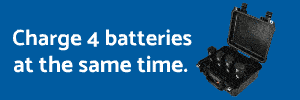There is no limit to the number of CARRY-ON batteries that are rated under 100Wh. Mavic2 batteries and Phantom batteries are both under 100Wh. You cannot check your hard case with batteries inside, it must be carried on the craft, and fall within the 22X14X9" size limit (no problem for the
M2Z). Although there are no requirements to cover the battery connectors, it's a good idea to so do if you want to be diligent about safety. There is a requirement to individually protect each battery from shorts. I always keep my batteries separated from other batteries and any metal items that might short the battery by putting the batteries in separate compartments in my backpack. This is technically an acceptable method to "protect against shorts", which I find more convenient than the hassle of messing with connector covers. When traveling for business (unrelated to drones), which I do a lot, I use a backpack for my
M2Z because it's more convenient at the airport, and when I hike to my launch site at my travel destination. When hiking, wearing a backpack is less suspicious looking than carrying a hard case when in the hills, or other local hiking/biking trails. Biking with an
M2Z backpack is also enabling, with access to places you otherwise wouldn't, hard cases don't work for that very well. You don't want people thinking you're a bomber, or anything like that, as in today's society anything is possible. I like to be as remote as possible when I launch, with no people around when I launch, so hiking is often part of my SOP to access decent launch sites.
This backpack has worked out great, having 2 pockets on the outside that fit the
M2Z batteries perfectly. I keep one battery in the craft, and another battery inside the pack in a separate compartment, made with the Velcro adjustable compartment walls. This is a total of 4 batteries, which for me is ideal. I usually only fly 3 batteries max, which is 1 hour of flying, but I like to have an extra just in case.
My backpack will actually fit under the airline seat in a pinch. My Phantom backpack won't, it must be go in the overhead, which means you must make sure you board early enough before all of the overhead space is taken. Southwest can be sketchy when boarding in C group. With my
M2Z backpack, it's so small that when I put it in the overhead, there's enough room to put my business briefcase in front of it, taking up the same room as a regular 22X14X9" size suitcase. Normally the stewardesses don't like you putting small briefcases in the overhead, saving room for the bigger items, so I wait until everyone has their luggage stowed and plane door is shut. Then I put my briefcase in front of my
M2Z backpack, since there's always enough room. I like that aspect of the smaller
M2Z backpack, no possible with my Phantom backpack.
Backpacks have more room and versatility inside than hard cases. They are way more versatile for compartment organization, lighter to carry, cheaper to buy and less suspicious when toting around in public. Since you have to keep the drone with you at all times while traveling anyway, the treatment of the backpack is always pretty gentle (unless you have a habit of dropping things), negating the notion that a hard case offers more protection. True that a hard case will withstand a 5' drop onto concrete better, but when will that ever happen in real life? I recommend to all my friends to use a backpack for the many conveniences it offers traveling with the
M2Z, which is a great drone.
Lastly, there is no regulation for traveling with batteries discharged. A discharged battery has enough power left in the battery to start a fire just as easy as a charged battery if shorted, so there is no advantage to travelling a discharged battery, especially when the batteries are with you in the overhead storage, where any problem can be accessed immediately. I always travel with charged batteries because I will often drive right too a pre-planned flight area when I arrive my destination, assuming my business plans allow for it (that's a matter of planning). For instance, flying to the East coast from the West coast, in the summer, usually the plane lands in time for an epic golden hour drone flight, ideal for an immediate flight along the coastline, etc.










